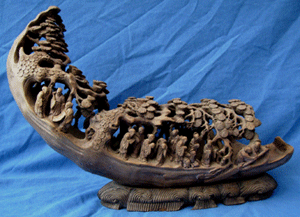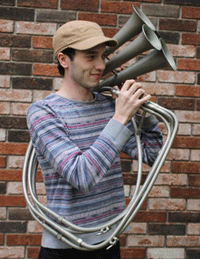|
$5,029 (36 bids): Carved Chinese Bamboo Boat, Immortals, Late Qing Dynasty. A hollow section of bamboo root carved as a gathering of Immortals and Scholars, with leafy pine tree canopy and wave-shaped hardwood stand. Condition: the wood is dry, dusty and uncleaned, two heads missing, and possibly a section of pine canopy near the back of the boat; a few small age lines. The base is attached with two screws. No other damage or repairs. Would look stunning cleaned and waxed. Size: 15 inches long. Marks: unmarked, remnants of red wax seal to underside of boat. Circa Qing 18th-19th century. (Photo: eBay seller mark xl5.)
 DBA: This type carving of the Immortals was usually done in ivory or bamboo (and sometimes jade). This is a high price for such an item, but this carving is unusually large and very detailed. DBA: This type carving of the Immortals was usually done in ivory or bamboo (and sometimes jade). This is a high price for such an item, but this carving is unusually large and very detailed.
With this being a United Kingdom seller, the ban on selling ivory in the U.S. would not apply. I could not find the buyer’s nationality as it is not listed. Many people are unaware that it is now illegal to sell ivory in the U.S. Before July 1, 2014, it was legal to sell antique ivory but not vintage or new ivory. There are bills before Congress trying to make it possible to again sell antique ivory. I have seen some smaller auction houses still continuing to sell ivory, but beware that these objects could be confiscated. If you consign your ivory with the auction house and the government agents take it, you will not be compensated. If you buy from an overseas source and try to import it to the U.S., it most likely will be confiscated, and you will lose the object.
I have discussed this ivory controversy because I do think that this will affect the value of this type of object in the future. I wish I could tell you what Congress will do concerning the ivory ban. This could affect the value of any Immortal carving.
* * * * * * * * * * * * * * * * *
 $315 15 (18 bids): Nickel Brass, 4-Bell, 2-Valve, German Schalmei Trumpet Horn, made by Signal VEB. It is called a German Schalmei. I thought that four separate bells were unusual, but there are examples that have up to 16 bells and up to four valves. These instruments must have a unique sound. I was only able to find one other example on the net that is as large as the example we are listing, and it only had two bells. This nickel-over-brass Schalmei measures 37 inches from the lip of the bell to the back of the large curve, by 24 inches wide. (Photo: eBay seller wwolst12.) $315 15 (18 bids): Nickel Brass, 4-Bell, 2-Valve, German Schalmei Trumpet Horn, made by Signal VEB. It is called a German Schalmei. I thought that four separate bells were unusual, but there are examples that have up to 16 bells and up to four valves. These instruments must have a unique sound. I was only able to find one other example on the net that is as large as the example we are listing, and it only had two bells. This nickel-over-brass Schalmei measures 37 inches from the lip of the bell to the back of the large curve, by 24 inches wide. (Photo: eBay seller wwolst12.)
DBA: This instrument was primarily used as a signaling instrument for military groups. It evolved from an earlier type of horn and is actually considered a precursor to the oboe. I had to search the Internet to find people playing the instrument and to hear it. Apparently, its use is limited as I have never heard of anyone getting a college scholarship to play this instrument. The number of bells or horns varies from two to 16. Condition plays an important part of the pricing. I could not find that a larger number of horns meant more money. The quality of the material will make a difference in the pricing. This is probably a good buy.
* * * * * * * * * * * * * * * * *
$5,600 (61 bids): 1820 Antique English Pieced Coverlet Quilt Early Chintz, 18th century. Wear appropriate to age and use. The overall feel of the piece is fresh and usable. I counted 14 tiny piecings that had decay. There is staining to the reverse and one cut in the corner. There is foxing and some damp-staining to the front and in one corner a darker yellow stain. Dimensions: 90 1/4 x 92 inches.
For years I have lived with, loved, and admired the way this quilt (or appliquéd coverlet or pieced coverlet—I do not know the correct technical term; there is no batting between the top and bottom layers) works its magic in a variety of living spaces. Based on my own inevitable reaction—and far more importantly, the reactions of friends, acquaintances and complete strangers when it is laid out on a bed—here is a list of words and phrases that come immediately to mind: charming, enchanting, homey, endearing, exquisite, comforting, gorgeous, hypnotic, superbly made, painstakingly designed and astonishing variety of period prints.
Even when combing it for damaged little appliqués (I counted 14, but there may be more), I was constantly sidetracked with admiration for the rare printed chintzes represented here, together with the minute care used by the needlewoman or women who designed it. Taking the time to cut out a little butterfly or position a flower just so. It is a true labor of love.
Speaking of chintz, as the sun was setting in the garden during my photography session, I noticed that even after all these years, it retains a very soft glint—chintzes being polished at the time of its making. There are well in excess of 1,600 little pieces of chintz on this quilt, most of them, in the main field, hexagons and in the borders, diamonds.
One could make a long list of its imperfections, and yet, the overall presence of the piece is fresh, alive, and strong. I promise you this: if you spread it out on a bed, you will not be able to tear yourself from the room. (Photo: eBay seller sonjonny.)
DBA: Quilting was done in England in very early times, even medieval times. Clothing as well as bed covering was quilted. Quilting was particularly important to Americans for several reasons. In early times, commercial fabric was imported and expensive. It was machine-made and more tightly woven and held up better than homespun. Fabric was very expensive, and saving scraps for additional uses was important to the economic well-being of the family. Quilted fabrics provided warmth as well as a creative outlet for women at that time. Every American household had quilts. Quilts were not as common in England where industrial equipment and the manufactured goods were more available.
This “quilt” is made of period chintz and is unusual, and that is an important factor in this object. While $5,600 is a lot to pay for a “quilt”, this one is very rare and beautiful. I think that this area of collecting will not lose in popularity.
* * * * * * * * * * * * * * * * *
$9,200 (19 bids): 1877 Westinghouse Fan. This rare antique 1877 Westinghouse 50-volt fan was found in the display case with plaque as shown at an antique flea market. The plaque gives the details that the fan was “…first used in the office of W.O. Randlett, Plant Supt. At the Manchester Station in 1887 and was in continuous use until the voltage was changed to 110 V.” (Photo: eBay seller greystoke74.)
DBA: As always, there are many collectors of early electric equipment. This fan does not even have a cage around the blades, and the blades are not rounded. Rounded blades were an early improvement. The addition of the cage was actually done to protect the blades and not the limbs of people. The office of the person who owned this fan is an unusual addition to it, although the person is not readily known. This fan sold for about three times the average rate for old fans. My belief is there are so few “open blade” fans around that this is the major reason for the high selling price. Given the number of collectors and the strong interest (and rarity of this fan), I would think that this was a good buy.
|